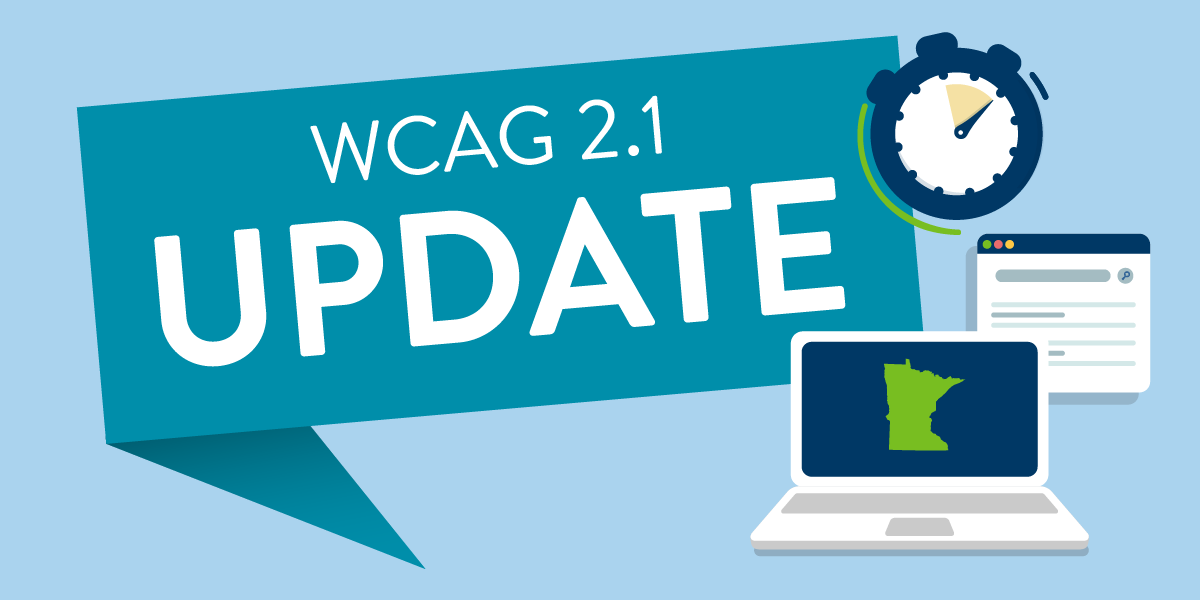Chief Information Accessibility Officer Jay Wyant answers questions about the updated Standard and its impact.
2/22/2024 10:44:36 AM

In February 2024, the Office of Accessibility announced the new Standard will go into effect on July 1, 2024. Efforts to create awareness and provide training will be ongoing through July, 2024.
The State of Minnesota published the first Digital Accessibility Standard September 1, 2010. The 2009 State Legislature had required that this new standard include Section 508 of Federal law and Web Content Accessibility Guidelines (WCAG) 2.0, Level AA.
The /mnit/assets/Stnd_State_Accessibility_tcm38-61585.pdfcurrent version (PDF) was effective June 14, 2018 to reflect the Section 508 refresh.
In 2018, the World Wide Web Consortium (W3C) published WCAG 2.1.
In 2021, a cross-agency team of State Digital Accessibility Coordinators (DACs) and Office of Accessibility staff launched a study to determine the benefits of WCAG 2.1. They recommended that Minnesota should update the State’s Standard and provide relevant outreach and training for State of Minnesota employees.
From 2021 to present, the Office of Accessibility coordinated several statewide events to provide information on WCAG 2.1 and collect feedback on what State employees needed to get ready. We also revised the current Standard with updated 2.1 content.
We worked with a steering committee and subject matter expert groups beginning in April 2023. Leaders from a variety of roles throughout the state provided direction, reviewed available training, and created information to prepare state employees.
Accessibility matters. Digital accessibility helps ensure everyone, including people with disabilities, has equal access to information, resources and services. This encompasses all things digital, from electronic documents to websites to kiosks.
Web Content Accessibility Guidelines (WCAG) provide a framework to plan, design, build and test digital information and technology so that it is accessible for all. The World Wide Web Consortium, or W3C for short, provides standards and guidelines for how the web works. For example, what you see at the beginning of a URL, https://, is a W3C recommendation.
The W3C set up the Web Accessibility Initiative, or WAI. WAI in turn manages the Working Groups that research and propose updates to WCAG. The most recent updates are:
Each update adds new criteria to the previous set, as well as removes the occasional criteria that is no longer relevant.
WCAG 3 is currently a working draft designed to be a complete reorganization on how to define and measure accessibility.
Section 508 is a Federal rule governing how Federal agencies must include accessibility requirements and processes when creating or buying digital technology, formally termed Information and Communication Technology (ICT). Section508.gov provides a broad framework of resources, training and guidance on how to support and comply with the rule.
The cross-agency team of Digital Accessibility Coordinators determined that supporting 2.1 would provide significant benefits to users of State government information and technology. The WCAG 2.1 Steering Committee evaluated the teams’ findings and supported the conclusion.
WCAG 2.1, published 10 years after 2.0, addressed significant gaps in 2.0, notably support for users with:
We wanted to involve a wide range of stakeholders to ensure a positive response when rolling out our awareness and training. We viewed the Standard update as an opportunity to significantly improve the State’s ability to deliver accessible content and technology to State employees and Minnesotans. While we didn’t get representation from every category we targeted, we ended up with a great group that had a real impact on our ability to succeed, with representation from the following categories:
The update adds 12 new success criteria at the A and AA levels. Supporting these criteria make it easier for people to use digital technology. Some of the criteria reinforce what should be well-established practice, such as the ability to orient a device horizontally or vertically. Other criteria, such as reflow, help us push our vendors to improve their support for accessibility.
The updated Standard also removes minimum dollar amounts for when the Standard applies.
The cross-agency team evaluated 2.2 and determined that it would be challenging to implement all the new criteria before vendors had enough time to build support for it in their technologies.
Since last summer, volunteer teams have worked hard to analyze how WCAG 2.1, Level AA impacted their specific role, and what they needed in order to prepare for success.
We built out a website specifically for State employees that details how the new criteria impacts each role and what to do to effectively incorporate the new criteria into their work. Sample roles include:
The list is more exhaustive than that, and we expect to add more roles as we mature.
Currently our public website’s accessible procurement site provides guidance for vendors (review it under the Products tab). We will update this tab to include WCAG 2.1 AA criteria.
Minnesotans expect State services and apps to simply work and be hassle-free. As we implement the new Standard over the next few years, we expect State apps and services to be even more accessible and easier to use.
There are many free and paid training opportunities out there. Subscribe to our newsletter to stay up to date on accessibility topics and training opportunities.
The W3C has a good introduction to accessibility fundamentals.
State employees can visit the Office of Accessibility extranet for additional, role-specific training.
Absolutely! MN.gov has a link in the footer, Report an accessibility issue. Use that link to report issues or offer suggestions.
Would you like to learn more about the accessibility work being done by Minnesota IT Services and the State of Minnesota? Once a month we will bring you more tips, articles, and ways to learn more about digital accessibility.
Accessibility
Accessibility